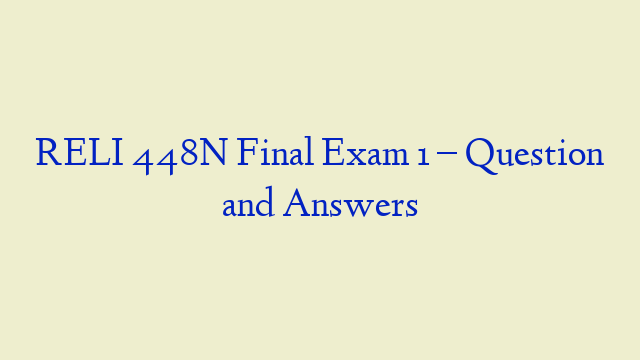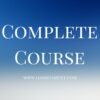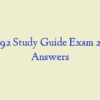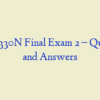Description
RELI 448N Final Exam
Page 1
- (TCO 1) A common element often found in religions is: (Pts: 4)
- (TCO 1) The position that argues that we cannot know whether there is a god or not is known as: (Pts: 4)
- (TCO 2) Who was the founder of psychoanalysis, who theorized that belief in a God or gods arose from an adult’s projection of powerful &long-lasting childhood experiences with his or her parents? (Pts: 4)
- (TCO 4) Who was the French sociologist who argued that religious behavior is relative to the society in which it is found &that a society will use a religion to reinforce its own values? (Pts: 4)
- (TCO 4) Name the American psychologist who viewed religion as positive way of fulfilling needs &praised its positive influence on the lives of individuals. (Pts: 4)
- (TCO 8) One feature that probably contributed to the rich developments in Hinduism was which of the following? (Pts: 4)
- (TCO 8) The term meaning non-harm or nonviolence is: (Pts: 4)
- (TCO 9) Hinduism, as formulated in the Upanishads, (Pts: 4)
- (TCO 10) The most accurate descriptor of Jainism is: (Pts: 4)
- (TCO 8) The Buddha’s first disciples were: (Pts: 4)
- (TCO 8) Once a person reaches nirvana: (Pts: 4)
- (TCO 8) By his teachings, Confucius hoped to: (Pts: 4)
- (TCO 8) Confucius thought the most important relationship was: (Pts: 4)
- (TCO 9) Which is not a Daoist value? (Pts: 4)
- (TCO 9) In Zhuangzi’s (Chuang Tzu’s) famous dream, he was not certain that he was not: (Pts: 4)
- (TCO 5) All of the following ancient world religions are minor religions except: (Pts: 4)
- (TCO 11) Sikhism is charaterized by: (Pts: 4)
- (TCO 6) A contract between the Hebrews &their God was called a: (Pts: 4)
- (TCO 6) The first King of Israel was: (Pts: 4)
- (TCO 6) God first appeared to Moses in: (Pts: 4)
- (TCO 7) The view that God’s imminent divine judgment &the end of the world is near is: (Pts: 4)
- (TCO 7) The most Jewish of the Gospels is: (Pts: 4)
- (TCO 6) Like Judaism, Islam forbids: (Pts: 4)
- (TCO 6) The Sunni &Shiite branches of Islam split over a dispute about: (Pts: 4)
- (TCO 12) Established groups of Wiccans are called: (Pts: 4)
Page 2
- (TCO 4) Compare &contrast a psychological view of religion (Freud, Jung, or James) with a sociological point of view (Durkheim or Levi-Strauss). Defend one of the two theories you selected as a better explanation for the origin of religions.
(Pts: 50) - Identify &analyze the Four Noble Truths, in particular, the Noble Eightfold Path. What ideas from Hinduism did Buddhism essentially keep? Describe them. Include enough details to support your answer.
- (TCO 3) Explain &evaluate Paley’s Teleological Argument for the Existence of God: In crossing a heath, suppose I pitched my foot against a stone&were asked how the stone came to be there, I might possibly answer that for anything I knew to the contrary it had lain there forever; nor would it, perhaps, be very easy to show the absurdity of this answer. But suppose I had found a watch upon the ground, &it should be inquired how the watch happened to be in that place, I should hardly think of the answer which I had before given, that for anything I knew the watch might have always been there. Yet why should not this answer serve for the watch as well as for the stone? Why is it not as admissible in the second case as in the first?
- (TCO 11) Identify &analyze three basic patterns in indigenous religions. Use examples from traditional Hawaiian religion to support your answer.












